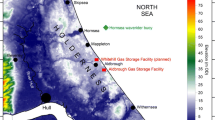Abstract
A detailed assessment of the impact of a far-field tsunami on the Australian coastline was carried out in the Steep Point region of Western Australia following the July 17 2006 Java tsunami. Tsunami inundation and run-up were mapped on the basis of eyewitness accounts, debris lines, vegetation damage and the occurrence of recently deposited fish, starfish, corals and sea urchins well above high-tide mark. A topographic survey using kinematic GPS with accuracies of 0.02 m in the horizontal and 0.04 m in the vertical recorded flow depths of between 1 and 2 m, inundation of up to 200 m inland, and a maximum recorded run-up of 7.9 m AHD (Australian Height Datum). The tsunami impacted the sparsely populated Steep Point coastline close to low tide. It caused widespread erosion in the littoral zone, extensive vegetation damage and destroyed several campsites. Eyewitnesses reported three waves in the tsunami wave train, the second being the largest. A sand sheet, up to 14 cm thick and tapering landwards over 200 m, was deposited over coastal dunes. The deposits are predominantly composed of moderately well-sorted, medium-grained carbonate sand with some gravel and organic debris. A basal unconformity defines the boundary between tsunami sediments and underlying aeolian dune sand. Evidence for up to three individual waves is preserved as normally graded sequences mantled by layers of dark grey, organic-rich fine silty sand. Given the strong wind regimes in the area and the similarity of the underlying dune deposits to the tsunami sediments, it is likely that seasonal erosion will remove all traces of these sediment sheets within years to decades.






Similar content being viewed by others
References
Burbidge D, Cummins C (2007) Assessing the threat to Western Australia from tsunami generated by earthquakes along the Sunda Arc. Nat Hazards 43:319–331
Fine IV, Cherniawsky JF, Rabinovich AB, Stephenson F (2008) Numerical modeling and observations of tsunami waves in Alberni Inlet and Barkley sound, British Columbia. Pure Appl Geophy 165:2019–2044
Fritz HM, Borrero JC (2006) Somalia field survey of the 2004 Indian Ocean tsunami. Earthq Spectra 22(S3):S219–S233
Fritz HM, Kongko W, Moore A, McAdoo B, Goff G, Harbitz C, Uslu B, Kalligeris N, Suteja D, Kalsum K, Titov V, Gusman A, Latief H, Santoso E, Sujoko S, Djulkarnaen D, Sunendar H, Synolakis C (2007) Extreme run-up from the 17 July 2006 java tsunami. Geophys Res Lett 34:1–5
Goff JR, Lane E, Arnold J (2009) The tsunami geomorphology of coastal dunes. Nat Hazards Earth Syst Sci 9:847–854
Intergovernmental Oceanic Commission (1998) Post-tsunami survey field guide. UNESCO Intergovernmental Manuals and Guides
Liu PL, Lynett P, Fernando H, Jaffe BE, Fritz H, Higman B, Morton R, Goff J, Synolakis C (2005) Observations by the international tsunami survey team in Sri Lanka. Science 308:1595
Murty TS, Nirupama N, Nistor I, Rao AD (2005) Why the Atlantic generally cannot generate transoceanic tsunamis? ISET J Earthq Technol 42:227–236 Technical Note
Okal EA, Fritz HM, Synolakis C, Raad HE, Al-Shijbi Y, Al-Saifi M (2006) Field survey of the 2004 Indonesian tsunami in Oman. Earthq Spectra 22(S3):S203–S218
Pattiaratchi CB, Wijeratne EMS (2009) Tide gauge observations of 2004–2007 Indian Ocean tsunamis from Sri Lanka and Western Australia. Pure Appl Geophys 166:233–258
Playford PE (1990) Geology of the Shark Bay area, Western Australia. In: Berry PF, Bradshaw SD, Wilson BR (eds) Research in Shark Bay: report of the France-Austral Bicentenary expedition committee. Western Australian Museum, Perth, pp 13–32
Acknowledgments
The authors thank Geoscience Australia and the Australian Tsunami Warning Centre for providing funding for fieldwork. The ranger at Steep Point, Paul Dickinson, provided invaluable local knowledge and accommodation.
Author information
Authors and Affiliations
Corresponding author
Rights and permissions
About this article
Cite this article
Prendergast, A.L., Brown, N. Far-field impact and coastal sedimentation associated with the 2006 Java tsunami in West Australia. Nat Hazards 60, 69–79 (2012). https://doi.org/10.1007/s11069-011-9953-y
Received:
Accepted:
Published:
Issue Date:
DOI: https://doi.org/10.1007/s11069-011-9953-y




